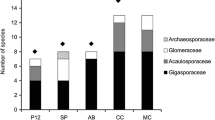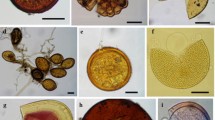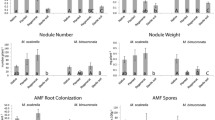Abstract
Yam (Dioscorea spp.) is a tuberous staple food crop of major importance in the sub-Saharan savannas of West Africa. Optimal yields commonly are obtained only in the first year following slash-and-burn in the shifting cultivation systems. It appears that the yield decline in subsequent years is not merely caused by soil nutrient depletion but might be due to a loss of the beneficial soil microflora, including arbuscular mycorrhizal fungi (AMF), associated with tropical “tree-aspect” savannas and dry forests that are the natural habitats of the wild relatives of yam. Our objective was to study the AMF communities of natural savannas and adjacent yam fields in the Southern Guinea savanna of Benin. AMF were identified by morphotyping spores in the soil from the field sites and in AMF trap cultures with Sorghum bicolor and yam (Dioscorea rotundata and Dioscorea cayenensis) as bait plants. AMF species richness was higher in the savanna than in the yam-field soils (18–25 vs. 11–16 spp.), but similar for both ecosystems (29–36 spp.) according to the observations in trap cultures. Inoculation of trap cultures with soil sampled during the dry season led to high AMF root colonization, spore production, and species richness (overall 45 spp.) whereas inoculation with wet-season soil was inefficient (two spp. only). The use of D. cayenensis and D. rotundata as baits yielded 28 and 29 AMF species, respectively, and S. bicolor 37 species. AMF root colonization, however, was higher in yam than in sorghum (70–95 vs. 11–20%). After 8 months of trap culturing, the mycorrhizal yam had a higher tuber biomass than the nonmycorrhizal controls. The AMF actually colonizing D. rotundata roots in the field were also studied using a novel field sampling procedure for molecular analyses. Multiple phylotaxa were detected that corresponded with the spore morphotypes observed. It is, therefore, likely that the legacy of indigenous AMF from the natural savanna plays a crucial role for yam productivity, particularly in the low-input traditional farming systems prevailing in West Africa.








Similar content being viewed by others
References
Adjakidje V (1984) Contribution à l’étude botanique des savanes guinéennes de la République Populaire du Bénin. Université de Bordeaux III, Bordeaux, - Thèse du troisième cycle
Adjanohoun EJ (1989) Contribution aux études ethnobotaniques et floristiques en République Populaire du Bénin. Agence de Coopération Culturelle et Technique, Paris
Ahn PM (1993) Tropical soils and fertiliser use. Longman Scientific & Technical, Edinburgh
Ahulu ME, Nakata M, Nonaka M (2005) Arum- and Paris-type arbuscular mycorrhizas in a mixed pine forest on sand dune soil in Niigata Prefecture, Central Honshu, Japan. Mycorrhiza 15:129–136. doi:10.1007/s00572-004-0310-9
Altschul SF, Madden TL, Schaeffer AA (1997) Gapped BLAST and PSI-BLAST: a new generation of protein database search programs. Nucleic Acids Res 25:3389–3402. doi:10.1093/nar/25.17.3389
Baimey H (2005) Scutellonema bradys as a pathogen of yam in Benin. PhD Thesis. University of Pretoria. Pretoria, South Africa, pp 146
Baimey H, Coyne D, Labuschagne N (2005) Assessment of inoculation methods in evaluating response of yam cultivars to infection by Scutellonema bradys. Nematology 7:375–379. doi:10.1163/156854105774355518
Baimey H, Coyne D, Labuschagne N (2006) Effect of fertilizer application on yam nematode (Scutellonema bradys) multiplication and consequent damage to yam (Dioscorea spp.) under field and storage conditions in Benin. Int J Pest Manage 52:63–70. doi:10.1080/09670870600552380
Bakhtiar Y, Miller D, Cavagnaro T, Smith S (2001) Interactions between two arbuscular mycorrhizal fungi and fungivorous nematodes and control of the nematode with fenamifos. Appl Soil Ecol 17:107–117. doi:10.1016/S0929-1393(01)00129-9
Bever JD, Morton JB, Antonovics J, Schultz PA (1996) Host-dependent sporulation and species diversity of arbuscular mycorrhizal fungi in a mown grassland. J Ecol 84:71–82. doi:10.2307/2261701
Bever JD, Schultz PA, Pringle A, Morton JB (2001) Arbuscular mycorrhizal fungi: more diverse than meets the eye, and the ecological tale of why. Bioscience 51:923–931. doi:10.1641/0006-3568(2001)051<0923:AMFMDT>2.0.CO;2
Brundrett M, Melville L, Peterson L (1994) Practical Methods in Mycorrhizal Research. Mycologue Publications, University of Guelph, Guelph, Ontario, Canada
Caglar S, Akgun A (2006) Effects of vesicular-arbuscular mycorrhizal (VAM) fungi on the seedling growth of three Pistacia species. J Environ Biol 27:485–489
Carsky RJ, Wolo N, Manyong VM, Tian G (2001) Nutrient balance model for design of sustainable in yam cropping systems. In: Akoroda MO, Ngeve JM (eds) Tropical Root Crops. Proceedings of the 7th Triennal Symposium of the International Society for Tropical Root Crops-Africa Branch, Cotonou, Benin, pp 198–209
Chaurasia B, Hare PK (2005) Hordeum vulgare: a suitable host for mass production of arbuscular mycorrhizal fungi from natural soil. Appl Ecol Environ Res 4:45–53
Coursey DG (1984) Potential utilization of major root crops, with special emphasis on human, animal and industrial uses. In: Terry ER, Doku EV, Arene OB, Mahungu NM (eds) Tropical Root Crops: Production and Uses in Africa. Proceedings of the Second Triennial Symposium of the International Society for Root crops, Africa Branch, Duala, Cameroun, 14-19 August 1983, pp 25–35
Dalpé Y, Diop TA, Plenchette C, Gueye M (2000) Glomales species associated with surface and deep rhizosphere of Faidherbia albida in Senegal. Mycorrhiza 10:125–129. doi:10.1007/s005720000069
Dare M, Fagbola O, Asiedu R (2007) Heritability estimates of arbuscular mycorrhizal colonisation in Dioscorea species in yam growing regions of Nigeria. Proceedings of "Deutscher Tropentag" conference: Utilisation of diversity in land systems: Sustainable and organic approaches to meet human needs. Abstract for Poster section, Tropentag, October 9-11, 2007, Witzenhausen, Germany
Egesi CN, Odu BO, Ogunyemi S, Asiedu R, Hughes J (2007a) Evaluation of water yam (Dioscorea alata L.) germplasm for reaction to yam antracnose and virus disease and their effect on yield. J Phytopathol 155:536–543. doi:10.1111/j.1439-0434.2007.01273.x
Egesi CN, Onyeka TJ, Asiedu R (2007b) Severity of anthracnose and virus desease on water yam (Dioscorea alata L.) in Nigeria I. Effects of yam genotype and date of planting. Crop Prot 26:1259–1265. doi:10.1016/j.cropro.2006.10.025
FAO (2007) Food and Agriculture Organization of the United Nation, Rome
FAOSTAT data (2007) Food and Agriculture Organization of the United Nation, Rome
Ferguson UT (1973) The effect of set characteristics and spacing on growth, development and yield of yams (Dioscorea spp). PhD thesis, University of the West Indies St. Augustine, Trinidad, West Indies, 219 pp
Gai JP, Christie P, Feng G, Lu XL (2006) Twenty years of research on community composition and species distribution of arbuscular mycorrhizal fungi in China: a review. Mycorrhiza 16:229–239. doi:10.1007/s00572-005-0023-8
Giovannetti M, Mosse B (1980) An evaluation of techniques for measuring vesicular arbuscular mycorrhizal infection in Roots. New Phytol 84:489–500. doi:10.1111/j.1469-8137.1980.tb04556.x
Husband R, Herre EA, Turner SL, Gallery R, Young JPW (2002) Molecular diversity of arbuscular mycorrhizal fungi and patterns of host association over time and space in tropical forest. Mol Ecol 11:2669–2678. doi:10.1046/j.1365-294X.2002.01647.x
IITA (2005) Annual Report of the International Institute of Tropical Agriculture. IITA-Ibadan, Nigeria
IITA (2006) Annual Report of the International Institute of Tropical Agriculture. IITA, Ibadan, Nigeria
Ile EI, Craufurd PQ, Battey NH, Asiedu R (2006) Phases of dormancy in yam tubers (Dioscorea rotundata). Ann Bot (Lond) 97:497–504. doi:10.1093/aob/mcl002
Ile EI, Craufurd PQ, Asiedu R, Battey NH (2007) Duration from vine emergence to flowering suggests a long-day or rate of change of photoperoid response in white yam (Dioscorea rotundata Poir.). Environ Exp Bot 60:86–94. doi:10.1016/j.envexpbot.2006.06.009
Kalu BA, Erhabor PO (1990) Production and econimic evaluation of white yam (Dioscorea rotundata) minisetts under ridge and bed production systems in a tropical Guinea savanna location, Nigeria. Trop Agric 69:78–82
Klironomos JN, Bednarczuk EM, Neville J (1999) Reproductive significance of feeding on saprophytic and arbuscular mycorrhizal fungi by the collembolan, Folsomia candida. Funct Ecol 13:756–761. doi:10.1046/j.1365-2435.1999.00379.x
Lekberg Y, Koide RT, Rohr JR, Aldrich-Wolfe L, Morton JB (2007) Role of niche restrictions and dispersal in the composition of arbuscular mycorrhizal fungal communities. J Ecol 95:95–105. doi:10.1111/j.1365-2745.2006.01193.x
Lovelock CE, Andersen K, Morton JB (2003) Arbuscular mycorrhizal communities in tropical forests are affected by host tree species and environment. Oecologia 135:268–279
Maduakor HO, Lal R, Opar-Nadi OA (1984) Effects of methods of seedbed preparation and mulching o the growth and yield of white yam (Dioscorea rotundata) on an Ultisol in south-east Nigeria. Field Crops Res 9:119–130. doi:10.1016/0378-4290(84)90018-2
Mathimaran N, Ruh R, Jama B, Verchot L, Frossard E, Jansa J (2007) Impact of agricultural management on arbuscular mycorrhizal fungal communities in Kenyan Ferralsol. Agric Ecosyst Environ 119:22–32. doi:10.1016/j.agee.2006.06.004
Ng SYC (1988) In vitro tuberization in white yam (Dioscorea rotundata Poir). Plant Cell Tissue Organ Cult 14:121–128. doi:10.1007/BF00041185
Ng SYC (1992) Micropropagation of white yam (Dioscorea rotundata Poir). In: Bajaj YPS (ed) Biotechnology in Agriculture and Forestry, vol. 19. High Technology and Micropropagation 111. Springer-Verlag, Berlin, Germany, pp 135–159
Ng SYC (1994) Production and distribution of virus-free yam (Dioscorea rotundata Poir). In: Ofori IF, Hahn SK (eds) Proceedings of the 9th Symposium of the International Society of Tropical Root Crops, 20–26 October 1991. Accra, Ghana, pp 324–328
O’Sullivan JN, Jenner R (2006) Nutrient deficiencies in greater yam and their effects on leaf nutrient concentrations. J Plant Nutr 29:1663–1674. doi:10.1080/01904160600851569
O’Sullivan JN, Ernest J (2007) Nutrient deficiencies in lesser yam (Dioscorea esculenta) characterized using constant-water table sand culture. J Plant Nutr Soil Sci 170:273–282. doi:10.1002/jpln.200625049
Odu BO, Asiedu R, Hughes JA, SA Shoyinka SA, Oladiran OA (2004) Identification of resistance to yam mosaic virus (YMV), genus Potyvirus in white Guinea yam (Dioscorea rotundata Poir.). Field Crops Res 89:97–105. doi:10.1016/j.fcr.2004.01.009
Oehl F, Sieverding E, Ineichen K, Mäder P, Boller T, Wiemken A (2003) Impact of land use intensity on the species diversity of arbuscular mycorrhizal fungi in agroecosystem of Central Europe. Appl Environ Microbiol 69:2816–2824. doi:10.1128/AEM.69.5.2816-2824.2003
Oehl F, Sieverding E, Mäder P, Dubois D, Ineichen K, Boller T, Wiemken A (2004) Impact of long-term conventional and organic farming on the diversity of arbuscular mycorrhizal fungi. Oecologia 138:574–583
Oehl F, Sieverding E, Ineichen K, Ris E-A, Boller T, Wiemken A (2005) Community structure of arbuscular mycorrhizal fungi at different soil depths in extensively and intensively managed agroecosystems. New Phytol 165:273–283. doi:10.1111/j.1469-8137.2004.01235.x
Oehl F, Sieverding E, Wiemken A (2007) History and biogeography of arbuscular mycorrhizal fungi–a global view. In: Maia LC, Malosso E, Yano-Melo AM (eds) Micologia–avanços no conhecimento. 5° Congresso Brasileiro de Micologia, 11–16 November 2007. Recife, Brazil, pp 256–258
Oehl F, de Souza FA, Sieverding E (2008) Revision of Scutellospora and description of five new genera and three new families in the arbuscular mycorrhiza-forming Glomeromycetes. Mycotaxon 106:311–360
Olasantan FO (1999) Effect of time of mulching on soil temperature and moisture regime and emergence, growth and yield of white yam in western Nigeria. Soil Tillage Res 50:215–221. doi:10.1016/S0167-1987(98)00192-5
Onwueme IC, Haverkort JA (1991) Modelling growth and productivity of yams (Dioscorea spp.): Prospects and problems. Agric Syst 36:351–367. doi:10.1016/0308-521X(91)90015-3
Öpik M, Moora M, Liira J, Zobel M (2006) Composition of root-colonizing mycorrhizal fungal communities in different ecosystems around the globe. J Ecol 94:778–790. doi:10.1111/j.1365-2745.2006.01136.x
Orkwor GC (1998) The importance of yam. In: Orkwor GC, Asiedu R, Ekanayake IJ (eds) Food Yams: Advances in Research. IITA and NRCRI, Nigeria, pp 1–12
Oyetunji OJ, Afolayan ET (2007) The relationships between relative water content, chlorophyll synthesis and yield performance of yam (Dioscorea rotundata) as affected by soil amendments and mycorrhizal inoculation. Arch Agron Soil Sci 53:335–344. doi:10.1080/03650340601149310
Ravi V, Aked J, Balagopalan C (1996) Review on tropical root and tuber crops. I. Storage methods and quality changes. Crit Rev Food Sci Nutr 36:661–709
Redecker D (2000) Specific PCR primers to identify arbuscular mycorrhizal fungi within colonized roots. Mycorrhiza 10:73–80. doi:10.1007/s005720000061
Salako FK, Olowokere FA, Tian G, Kirchhof G, Osiname O (2007) Ground cover by three crops cultivated on marginal lands in southwestern Nigeria and implications fror soil erosion. Span J Agric Res 5:497–505
Sanginga N, Carsky RJ, Darshiell K (1999) Arbuscular mycorrhizal fungi respond to rhizobial inoculation and cropping systems in farmers’ fields in the Guinea savanna. Biol Fertil Soils 30:179–186. doi:10.1007/s003740050606
SAS Institute, Inc (2007) SAS User’s Guide: Statistics. SAS, Cary
Schenck NC, Pérez Y (1990) A manual for identification of vesicular-arbuscular mycorrhizal fungi. INAM University of Florida, Gainesville
Smith SE, Read DJ (2008) Mycorrhizal Symbiosis, 3rd edn. Academic Press, San Diego
Sotomayor-Ramirez D, Gonzalez-Velez A, Roman-Paoli E (2003) Yam (Dioscorea spp.) response to fertilization in soils of the semiarid sothern coast of Puerto Rico. J Agric Univ P R 87:91–103
Suja G, Nair VM, Sarawathy P, Pushpakumari R (2003) Plant population and sett size efects on white yam (Dioscorea rotundata Poir.) intercropped in coconut gardens. Trop Agric 80:157–162
Swofford DL (2001) PAUP*. Phylogenetic Analysis Using Parsimony (*and Other Methods). Sinauer, Sunderland
Sýkorová Z, Wiemken A, Redecker D (2007) Co-occurring Gentiana verna and Gentiana acaulis and their neighboring plants in two Swiss upper montane meadows harbor distinct arbuscular mycorrhizal fungal communities. Appl Environ Microbiol 73:5426–5434. doi:10.1128/AEM.00987-07
Tchabi A 2008. Arbuscular mycorrhizal fungi in the sub-Saharan savanns of Benin and their association with yam (Dioscorea spp.): Potential of yam growth promotion and reduction of nematode infestation. PhD thesis, University of Basel, Switzerland
Tchabi A, Coyne D, Hountondji F, Lawouin L, Wiemken A, Oehl F (2008) Arbuscular mycorrhizal fungal communities in sub-Saharan savannas of Benin, West Africa, as affected by agricultural land use intensity and ecological zone. Mycorrhiza 18:181–195. doi:10.1007/s00572-008-0171-8
Tiunov AV, Scheu S (2005) Arbuscular mycorrhiza and Collembola interact in affecting community composition of saprotrophic microfungi. Oecologia 142:636–642. doi:10.1007/s00442-004-1758-1
Uchendu EE (2000) Effect of arbuscular-mycorrhizal fungi inoculation on establishment of in-vitro Dioscorea rotundata plantlets in soil. B.Sc Thesis, University of Ibadan, Nigeria, 58p
Valenzuela HR, DeFrank J (1995) Agroecology of tropical underground crops for small-scale agriculture. Crit Rev Plant Sci 14:213–238. doi:10.1080/713608116
Vandenkoornhuyse P, Husband R, Daniell TJ, Watson J, Duck JM, Fitter AH, Young JPW (2002) Arbuscular mycorrhizal community composition associated with two plant species in a grassland ecosystem. Mol Ecol 11:1555–1564. doi:10.1046/j.1365-294X.2002.01538.x
Vander Zaag P, Fox RL (1980) The phosphorus requirements of yams (Dioscorea spp.). Trop Agric 57:97–106
Acknowledgement
We thank Kurt Ineichen for his help and advice for maintaining the AMF. The work supported by grants from the Swiss Center for International Agriculture (ZIL: http://www.rfpp.ethz.ch), the Indo-Swiss Collaboration in Biotechnology (ISCB: http://iscb.epfl.ch/), and the Swiss National Science Foundation.
Author information
Authors and Affiliations
Corresponding author
Rights and permissions
About this article
Cite this article
Tchabi, A., Burger, S., Coyne, D. et al. Promiscuous arbuscular mycorrhizal symbiosis of yam (Dioscorea spp.), a key staple crop in West Africa. Mycorrhiza 19, 375–392 (2009). https://doi.org/10.1007/s00572-009-0241-6
Received:
Accepted:
Published:
Issue Date:
DOI: https://doi.org/10.1007/s00572-009-0241-6




